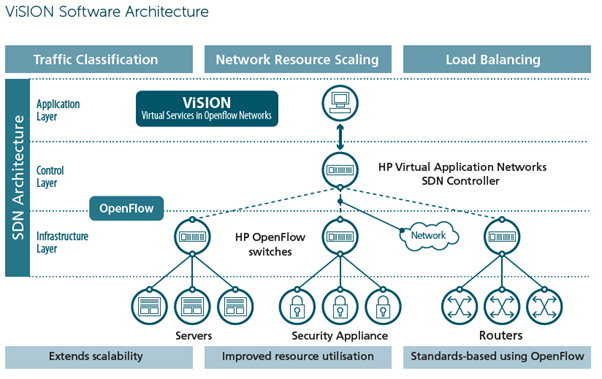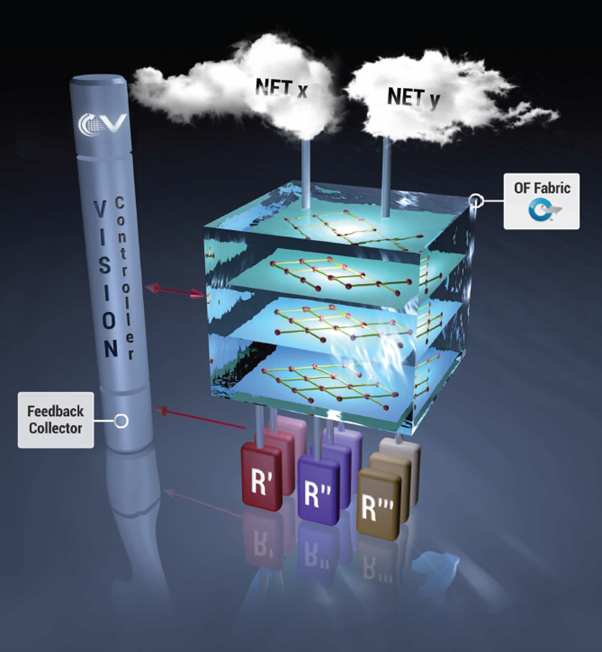Networking - Activities Covering 2012
In 2012, the WIND (Wireless Infrastructure Network Deployment) project was launched to carry out a research activity and provide new algorithms, guidelines and solutions to support the deployment and operation of the Wi-Fi infrastructure at CERN. This research activity is now producing extremely concrete results and provides CERN’s Wireless Service with unique monitoring and diagnostic information. HP has also expressed interest in incorporating the developed technologies in their products.
Given the broad dynamic of Software Defined Networking (SDN), the Networking Competence Centre (NCC) grasped the potential of this technology for scaling out specific sections of CERN’s communication infrastructure. HP’s expertise and pioneering work in SDN combined with CERN’s challenges created an ideal opportunity to start a new joint project for pursuing this research topic: ViSION (Virtual Services in OpenFlow Networks).
Wi-Fi challenges
Compared to wired networks, the wireless installations pose many more challenges due to the nature of the radio-wave propagation, limited spectrum available and unpredictable user behaviour. In order to deploy a wireless network one has to perform site surveys and spend a lot of time in the detailed frequency planning. Once deployed, it is not always easy to assess much about the current health of the wireless network from the end-user point of view. There are no clear procedures which help pinpointing potential problems. Usually one does not know about a problem until signalled by the user himself. Even when signalled, it is actually difficult to find the root cause. In many cases, the diagnosis is part of a random trial-and-error process that is usually concluded by an on-site visit, which is time consuming. Running a large yet flexible and efficient wireless service is a complex process that requires much work.
The demand for wireless access is growing in all organisations and so are the user needs. BYOD (Bring Your Own Device) is on a rise and it is not uncommon for one user to have several wireless devices. Faster standards (802.11n) created a paradox. It was expected that the higher transmission rates would alleviate some of the previously known problems. Instead, it raised the user expectations, who now treat wireless as a viable alternative to cabled networking. Furthermore, the fact that end users are often unaware of the complexity of wireless deployment and operation adds to the difficulty. In the beginning the WIND team investigated the existing research papers, commercial solutions and future standards in order to identify the most promising directions to explore. The results of this research were published in 2010 in a report “Wireless Control and Optimisation”, by Milosz Hulbój and Vlad L?p?d?tescu.
CERN provides a particularly challenging environment for wireless networks. The demand for wireless access is growing and so are the user needs. There is a wide range of deployment areas: conference rooms, auditoria, long corridors, offices, warehouse-like buildings, assembly halls and underground installations. As of November 2012, there are over 750 HP base stations installed in over 170 different buildings. The biggest locations host a dense environment of more than 60 base stations. Daily, WIND observes over 10,000 distinct wireless stations with 60% out of them being registered as CERN devices. On average, there are 150 personal base stations operating in parallel to the official infrastructure (referred to as rogue access points).
WIND project findings
Experience from previous HPN-openlab network monitoring and anomaly detection project (CINBAD - CERN Investigation of Network Behavior Anomaly Detection) allowed the WIND team to build an efficient data collection system. Most of the data comes from the HP access points as it is currently not technically possible to collect data from wireless clients without installing special software on them. In order to infer about the performance and “wellness” of a wireless network, the WIND team assessed different metrics. Laboratory tests and real-life observations have demonstrated that the amount of time that a radio is using the wireless medium (either transmitting or receiving) allows for inferring about the network state and for identifying a broad range of problems. The team calls this metric a “channel time”. After being presented with encouraging results obtained with channel time estimates, HP decided to implement a more accurate way of measuring the channel time in their base stations. It allowed for more accurate identification of numerous wireless problems: co-channel interference, adjacent channel interference, hidden nodes, etc.
During the course of the project, WIND created multiple prototype perspectives for visualising different aspects of wireless network. Each of them was then carefully evaluated together with Sébastien Ceuterickx, the Wireless Service Manager, in order to select the most useful ones. At the same time, the WIND team analysed the most common reported wireless problems and the way in which the Wireless Service approached the problem. WIND was able to codify a part of the problem solving workflow into a decision system process. The rules were codified using the Drools system which allows for easy modification and extension by any user. Such a rule based tool allowed for creating a mechanism that automatically discovers the problems (both station and radio related) within CERN’s infrastructure.
The current WIND toolkit enables one to visualise detailed information on the actual state of the network at any point in time. This new facility improves day-to-day operations and reduces the time needed to diagnose network problems. All of these tools have already proven to be useful in resolving problems, including: radio misconfiguration, hidden nodes, station driver problems, co-channel interference, non-802.11 interferers (microwave ovens and wireless headphones) and many more. The WIND team focuses now on transforming the software created into a reliable service that could be used without detailed training by CERN’s network engineers to resolve Wi-Fi problems.
At the beginning of November, the WIND team visited the HPN wireless group once more in Montréal, Canada. The main goal of this visit was to present and discuss the latest results and to transfer the knowledge that was gathered during the course of the project. WIND ideas, tools and algorithms were very well received by engineers and product managers. HPN is considering integrating some of these ideas into their portfolio of products. This, together with the on-going deployment and integration at CERN is a clear evidence of the project’s achievements.
The ViSION project
ViSION is a three-year project that started in February 2012 in collaboration with HP Networking. The name stands for Virtual Services in OpenFlow networks, and its target is to optimise network resource utilisation using a Software Defined Networking approach based on the emerging OpenFlow technology. Software Defined Networking is a recent technology that exports the control/decision logic from the networking equipment to an external software controller, which has a global view of the network and can make educated traffic engineering decisions. This significantly differs from the traditional networking paradigm, where each node takes its own decisions. OpenFlow is the main protocol enabling SDN. It has been created by the need to accelerate innovation in the networking field, which has fallen behind software server virtualisation. Initially promoted in academic environments the protocol is now supported by the Open Networking Foundation, comprising the majority of networking manufacturers.
The goal of the ViSION project is to develop an application aware traffic orchestrator using OpenFlow. The orchestrator will distribute traffic over a set of network resources, performing both classification (different types of resources) and load sharing (similar resources). To make the goal achievable, the ViSION team has early access to the recently announced HP SDN APIs and the HP SDN controller. Currently, approximately one year into the project, the initial study and design phase was completed and work has started to develop a prototype.
A particular case of direct interest to CERN in order to cope with the increase of Internet traffic is scaling out its firewall system capacity by using the orchestrator to distribute traffic over multiple units. In light of HP’s new Virtual Application Networks SDN solution, HP has a direct interest in developing techniques for application specific traffic orchestration. Furthermore, ViSION will provide HP with valuable feedback on their SDN framework and OpenFlow implementation in their products.




